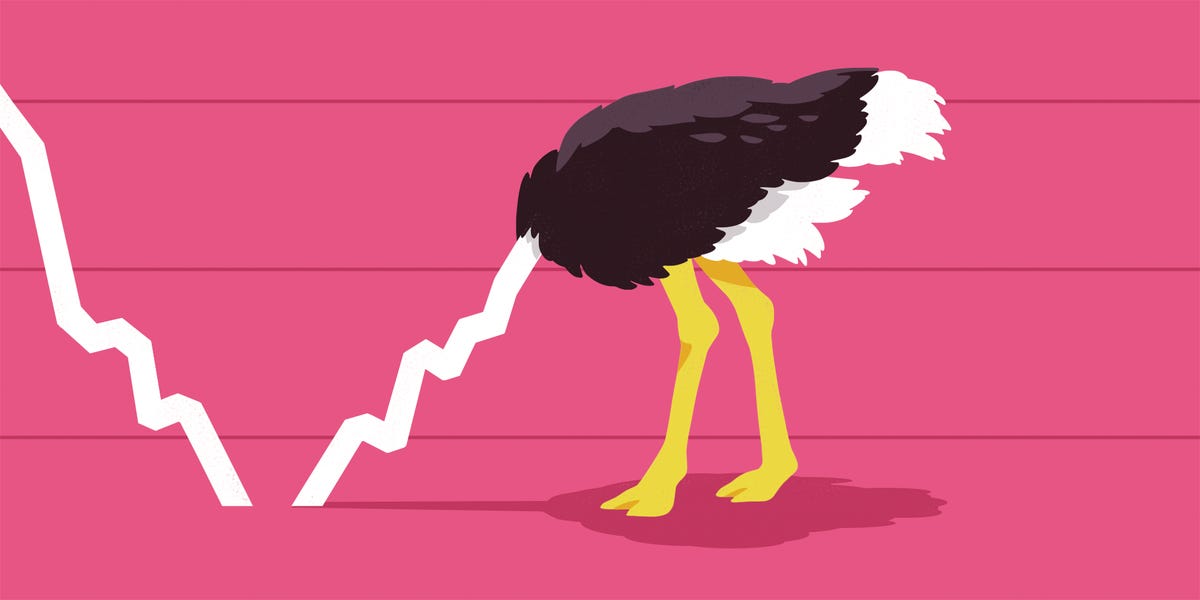When was the last time you picked up a phone call from an unknown number?
If you’re like most Americans, it’s probably been months since you took a chance with a random caller. The growing prevalence of phone spam isn’t just an all-too-frequent headache for people going about their days but also something warping the way we understand and treat the US economy.
Economics has a variety of tools that can help us figure out which parts of society are winning and which are losing. Some of these tools are what’s known as “hard data,” detailed datasets that actually measure things such as the output of businesses and household spending. Then there is “soft data,” surveys and polls that help us understand the lived experience of Americans — how they feel about the economy, how they expect their finances to change, and where they think the country is headed.
Since the onset of the pandemic, America’s economy has been bizarre in many ways, but there has been one especially hard-to-explain divergence that should worry everyone. The hard data is telling a story of a strong recovery: Frontline workers and lower-income households have been riding a turbocharged job market that has boosted GDP growth. But the soft, survey-based data is telling a different story: Households report massive economic pessimism that is more consistent with periods of extremely high unemployment, low economic growth, and general economic disaster.
There have been plenty of explanations for the divergence, but one reason is that the quality of the soft data we’re getting is deteriorating. Fewer people are responding to surveys about the economy, and those who do are more likely to be downplaying the positive aspects of our recovery. By underweighting the experience of certain groups — especially lower-income or frontline workers — policymakers could learn the wrong lessons from the post-pandemic economy. Without people seeing it as the most successful recession bounce back in history, this distorted view could push leaders to return to their bad habits from the 1980s to 2010s, when the fear of inflation and muted recession responses helped drive income inequality, left people out of work for longer, and even increased the mortality rate among less-educated Americans.
Returning to the bad old days of cautious post-recession policies wouldn’t just leave people poorer and slow down our economic growth, it would also be the result of a serious failure to listen to the voices and experiences of working Americans. To avoid this fate, we have to make serious efforts to change how we measure and talk about the US economy.
The Great Divergence
If you ask Americans how the economy is doing, the general sentiment can be summed up in one word: bad. The University of Michigan’s consumer confidence index hit a record low in June 2022, and while there has been a slight rebound recently, it remains below its long-term average. Similarly, the Conference Board’s consumer confidence data isn’t quite at its post-Great Recession lows, but it’s far below its 2017-19 average. Polls that ask Americans about the direction of the economy are also bleak with the share saying the country is headed in the right direction hitting a record low of 17.4% in July 2022, according to the RealClearPolitics polling average. While that has since rebounded to about 23%, it remains weak historically.
By contrast, most of the hard data is exceptionally strong. Real GDP growth has risen 3% a year from 2020 to 2024, above the 2.4% annual average from 2010 to 2019; real consumer spending has risen 3.8% a year versus 2.4% a year pre-COVID; and the job market is strong, with nearly record low unemployment.
One reason for this break between soft and hard data may lie in whom the economy is helping to lift up. The Bureau of Labor Statistics’ metric for average hourly earnings, which can be adjusted for changes in inflation, breaks out the wages of production and nonsupervisory workers — in other words, employees who are not managing other workers. The results are remarkable: Nonmanagerial workers saw their wages surge during the pandemic, jumping by 6% between February 2020 and its peak in April 2020. Inflation ate away at some of those gains, but the average nonmanager now earns 3.4% more an hour than they did at the end of 2019, even when accounting for inflation. Without adjusting for inflation, they earn 23.5% more an hour.
It’s a very different story for managers. While they also saw their real wages surge during the pandemic’s acute phase, inflation-adjusted average hourly earnings sank for 25 straight months — from January 2021 to January 2023 — and are now down by more than 7% compared with the end of 2019. To be clear, managers still earn 83% more an hour on average than line workers, but the relative change in earnings after accounting for inflation is dramatic. While frontline employees saw pay rise as much as inflation and more, managerial workers got hammered.
Other data sources back up the pattern. The Census’ most recent estimates of real median earnings showed incomes declining for almost every income bracket in 2022 — except for workers in the bottom 10% of the income distribution. That group saw real incomes rise at a historic rate, while the wealthiest households got hit the hardest.
Who actually replies to surveys
But why would that skew surveys asking how Americans feel about the economy? Surely, the gains for those at the bottom would offset the pessimism of everyone whose income sank. One explanation for the imbalance may come from whom the surveys are reaching.
Government agencies and private pollsters alike are having an increasingly difficult time persuading Americans to respond to their questions. Response rates for the Bureau of Labor Statistics’ monthly surveys have steadily collapsed over recent years, from about 70% a decade ago to roughly 50% in 2023. There are a variety of reasons for the rise in American blowing off surveys: wariness over telemarketers, a lack of interest in having their opinions heard, or a more general decline in the social trust that surveys rely on. No matter the reason, the rise in nonresponses makes it harder for economists to understand what people think.
If the people who don’t respond have something in common, that can skew the results of what would, on the face of it, seem like a useful survey. For instance, if you were trying to pick America’s favorite NFL team, but only polite Midwesterners picked up the phone when you called, you might get the impression that Americans back only the Minnesota Vikings, Green Bay Packers, or Chicago Bears. In reality, a nonresponse bias has skewed the data.
The BLS and Bureau of Economic Analysis have been careful to say that weak response rates aren’t making their data unusable, but it requires a substantial amount of adjustment and government-exclusive data to make the results helpful. And if that kind of number crunching is a challenge for large, well-funded statistical agencies, then the task is even greater for private pollsters that survey only a few hundred households. For instance, Pew reported in 2019 that the response rate for its telephone surveys had fallen from over one in three during the late 1990s to less than 10% by the late 2010s. Other pollsters have reported similar drops.
Even with adjustments, surveys run the risk of missing out on certain chunks of the population. To try to figure out who the people are that it’s most likely to miss, the Census Bureau used 2021 administrative (nonsurvey) data to estimate the characteristics of households that did not respond to its massive Current Population Survey’s Annual Social and Economic Supplements. The ASEC data uses a very large sample to provide the best possible insight into households’ economic well-being, with more than 75,000 households participating. Nonresponders skewed lower income, with the average responder earning about $5,000 more than nonresponders in 2020 and 2021. We can’t know for certain what other kinds of nonresponse bias might be lurking out there, but we know concretely that even very large, comprehensive samples undercount lower-income people.
The Census Bureau and other government agencies can adapt to that sort of bias because of the scale at which they’re operating — the census had an annual budget of almost $1.4 billion in fiscal 2022. But smaller operations paying for telephone surveys don’t have the tools or resources to make similar adjustments to their samples. That suggests that even though private consumer confidence data attempts to account for income and other factors, it may be missing out on many of the people who are seeing the biggest benefits of the economy.
Flying blind
While the football-fan example is an attempt at humor, the systemic underweighting of certain economic views has real-world consequences for how we talk about and treat the economy. For one thing, the more negative, managerial-class view of the economy has dominated most of the popular discussion over the past few years. Using a tracker that scans a slew of news sources for particular keywords and topics, we can see that inflation-related stories rose fourfold from the pre-COVID norm to the peak of inflation focus in early 2022. Similarly, the focus on the prospect of a recession soared, even outdoing the period in 2020 when the economy was actually in a recession. By contrast, mentions of strong wages only modestly increased over the pre-COVID baseline. In other words, the huge gains made by low-income workers didn’t make much of a blip in how the economy was discussed, while higher-income managerial workers’ plight with inflation took center stage. While the financial media’s bias toward negativity is part of a longer-term problem, the gap between good news and bad is staggering and asymmetric; it privileges the challenges of managers over the wins racked up by workers.
It would be one thing if working people already had an equal seat at the policymaking table, but they do not. Federal Reserve officials read opinion columns, and congressional staffers browse social media. Skewing that information diet heavily toward the plight of higher earners can only further privilege their preferred outcomes: Fighting inflation comes first, and getting people back into jobs comes second.
If this wealth-skewed view wins out during the next recession, we can get a pretty clear picture of how things will play out — reducing inflation, by definition, seeks to reduce people’s buying power and raise unemployment. That means less government stimulus in the event of a downturn, higher interest rates, and a willingness to let a recovery drag on. Reverting to our old way of dealing with recessions would also exacerbate inequality: Higher-income households are more likely to avoid losing their jobs and their wealth continues to grow as the stock market recovers, while on the other end, lower-income households face higher unemployment because of lower aggregate demand and weaker real wage growth due to weaker labor-bargaining power. All these factors serve to hurt the material conditions of working people, but they also concentrate political power in the hands of others.
There have been definitive winners and losers in the post-COVID economy. But how we measure the economy and listen to the voices of Americans has allowed the louder, wealthier voices to shape how leaders view the economic response. If we want policy that benefits working people, underweighting their experience in both “soft” and “hard” data is a huge mistake.
George Pearkes is the Global Macro Strategist for Bespoke Investment Group.


